ESP SKODA SUPERB 2009 2.G / (B6/3T) User Guide
[x] Cancel search | Manufacturer: SKODA, Model Year: 2009, Model line: SUPERB, Model: SKODA SUPERB 2009 2.G / (B6/3T)Pages: 294, PDF Size: 21.33 MB
Page 58 of 294
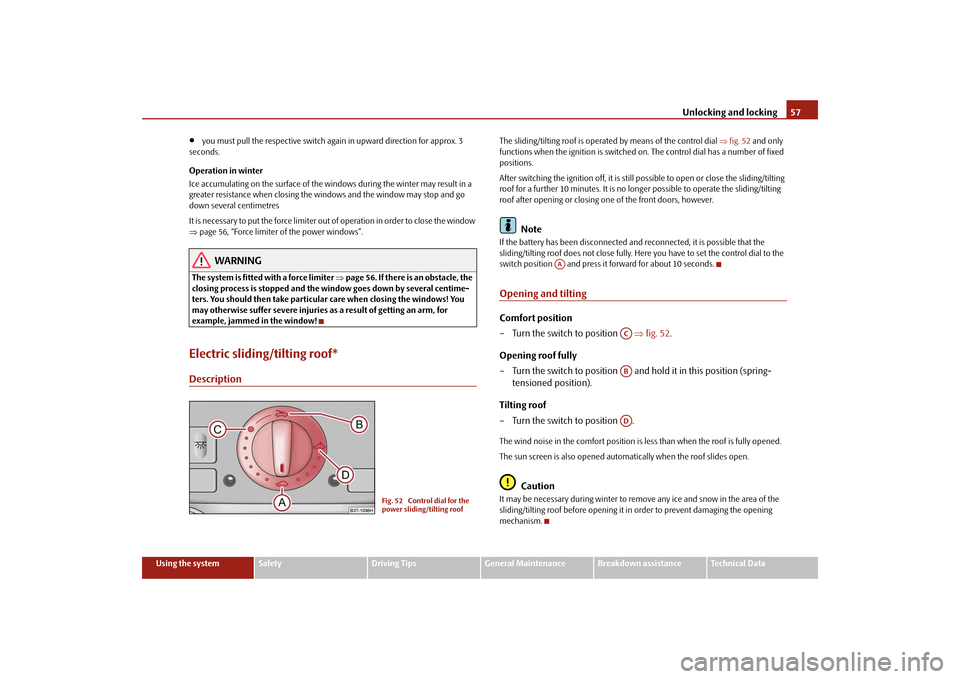
Unlocking and locking
57
Using the system
Safety
Driving Tips
General Maintenance
Breakdown assistance
Technical Data
•
you must pull the respective switch ag
ain in upward direction for approx. 3
seconds. Operation in winter Ice accumulating on the surface of the wi
ndows during the winter may result in a
greater resistance when closing the windows and the window may stop and go down several centimetres It is necessary to put the force limiter out of operation in order to close the window ⇒ page 56, “Force limiter of the power windows”.
WARNING
The system is fitted with a force limiter
⇒page 56. If there is an obstacle, the
closing process is stopped and the wi
ndow goes down by several centime-
ters. You should then take particular care when closing the windows! You may otherwise suffer severe injuries
as a result of getting an arm, for
example, jammed in the window!Electric sliding/tilting roof*Description
The sliding/tilting roof is operated by means of the control dial
⇒fig. 52
and only
functions when the ignition is switched on
. The control dial has a number of fixed
positions. After switching the ignition off, it is still possible to open or close the sliding/tilting roof for a further 10 minutes. It is no long
er possible to operate the sliding/tilting
roof after opening or closing on
e of the front doors, however.
Note
If the battery has been disconnected and reconnected, it is possible that the sliding/tilting roof does not close fully. Here you have to set the control dial to the switch position and press it
forward for about 10 seconds.
Opening and tiltingComfort position – Turn the switch to position
⇒
fig. 52
.
Opening roof fully – Turn the switch to position and
hold it in this position (spring-
tensioned position).
Tilting roof – Turn the switch to position .The wind noise in the comfort position is
less than when the roof is fully opened.
The sun screen is also opened automatically when the roof slides open.
Caution
It may be necessary during winter to remo
ve any ice and snow in the area of the
sliding/tilting roof before opening it in order to prevent damaging the opening mechanism.
Fig. 52 Control dial for the power sliding/tilting roof
AA
ACABAD
s2dk.1.book Page 57 Wednesday, April 8, 2009 12:23 PM
Page 63 of 294
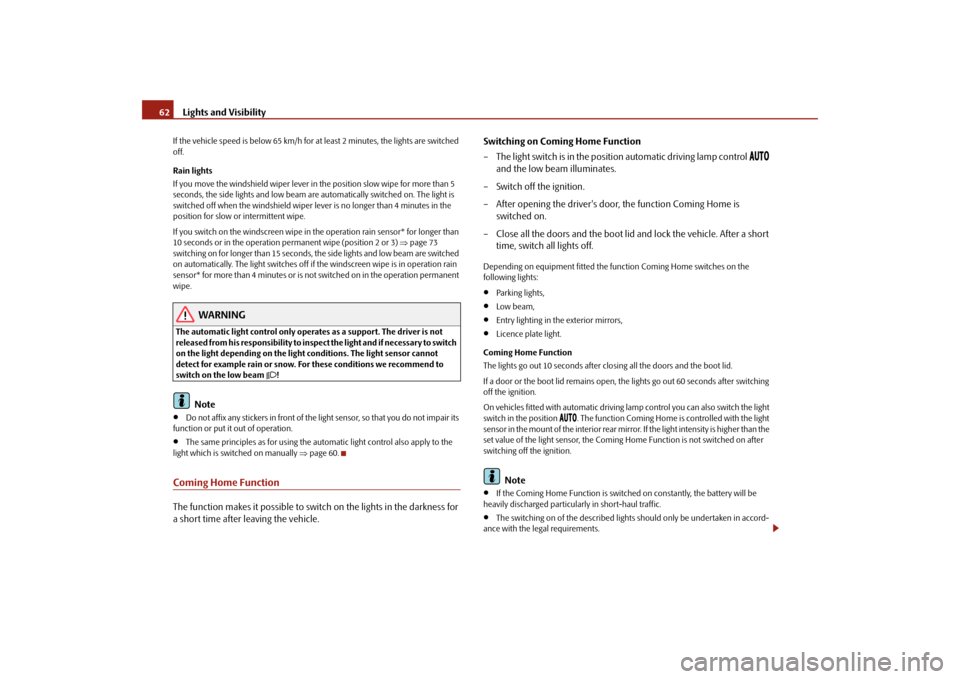
Lights and Visibility
62
If the vehicle speed is below 65 km/h for at least 2 minutes, the lights are switched off. Rain lights If you move the windshield
wiper lever in the position
slow wipe for more than 5
seconds, the side lights and low beam ar
e automatically switched on. The light is
switched off when the windshield wiper le
ver is no longer than 4 minutes in the
position for slow or intermittent wipe. If you switch on the windscreen wipe in
the operation rain sensor* for longer than
10 seconds or in the operation pe
rmanent wipe (position 2 or 3)
⇒page 73
switching on for longer than 15 seconds, th
e side lights and low beam are switched
on automatically. The light switches off if
the windscreen wipe is in operation rain
sensor* for more than 4 minutes or is no
t switched on in the operation permanent
wipe.
WARNING
The automatic light control only operat
es as a support. The driver is not
released from his responsibility to inspect the light and if necessary to switch on the light depending on the light
conditions. The light sensor cannot
detect for example rain or snow. Fo
r these conditions we recommend to
switch on the low beam
!
Note
•
Do not affix any stickers in front of the light sensor, so that you do not impair its
function or put it out of operation.•
The same principles as for using the au
tomatic light control also apply to the
light which is switched on manually
⇒page 60.
Coming Home FunctionThe function makes it possible to switch on the lights in the darkness for a short time after leaving the vehicle.
Switching on Coming Home Function – The light switch is in the positi
on automatic driving lamp control
and the low beam illuminates.
– Switch off the ignition. – After opening the driver's door, the function Coming Home is
switched on.
– Close all the doors and the boot lid and lock the vehicle. After a short
time, switch all lights off.
Depending on equipment fitted the func
tion Coming Home switches on the
following lights:•
Parking lights,
•
Low beam,
•
Entry lighting in the exterior mirrors,
•
Licence plate light.
Coming Home Function The lights go out 10 seconds after closing all the doors and the boot lid. If a door or the boot lid re
mains open, the lights go ou
t 60 seconds after switching
off the ignition. On vehicles fitted with automatic driving
lamp control you can also switch the light
switch in the position
. The function Coming Home is controlled with the light
sensor in the mount of the interior rear mirr
or. If the light intensity is higher than the
set value of the light sensor, the Coming Home Function is not switched on after switching off the ignition.
Note
•
If the Coming Home Function is switch
ed on constantly, the battery will be
heavily discharged particular
ly in short-haul traffic.
•
The switching on of the described lights
should only be undertaken in accord-
ance with the legal requirements.
s2dk.1.book Page 62 Wednesday, April 8, 2009 12:23 PM
Page 65 of 294
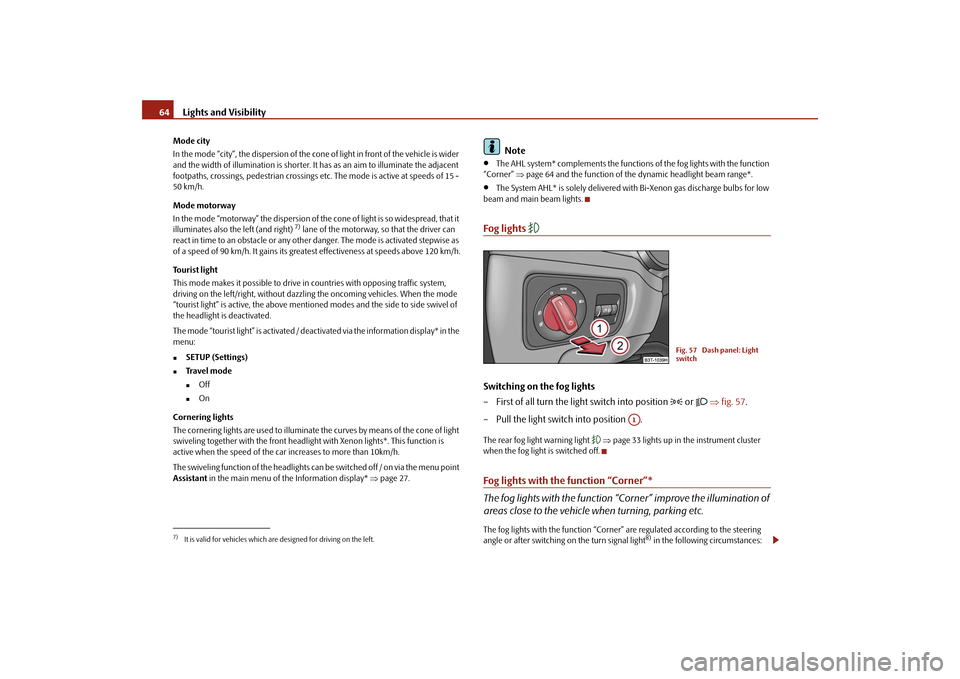
Lights and Visibility
64
Mode city In the mode “city”, the dispersion of the cone
of light in front of the vehicle is wider
and the width of illumination is shorter. It
has as an aim to il
luminate the adjacent
footpaths, crossings, pedestrian crossings etc. The mode is active at speeds of 15 - 50 km/h. Mode motorway In the mode “motorway” the disp
ersion of the cone of light is so widespread, that it
illuminates also the left (and right)
7) lane of the motorway, so that the driver can
react in time to an obstacle or any other
danger. The mode is activated stepwise as
of a speed of 90 km/h. It gains its greate
st effectiveness at speeds above 120 km/h.
Tourist light This mode makes it possible to drive in
countries with opposi
ng traffic system,
driving on the left/right, without dazzling the oncoming vehicles. When the mode “tourist light” is active, the above mentioned modes and the side to side swivel of the headlight is deactivated. The mode “tourist light” is activated / deac
tivated via the informat
ion display* in the
menu:�„
SETUP (Settings)
�„
Tra v e l m o d e�„
Off
�„
On
Cornering lights The cornering lights are used to illuminate the curves by means of the cone of light swiveling together with the front headlight with Xenon lights*. This function is active when the speed of the car increases to more than 10km/h. The swiveling function of the headlights ca
n be switched off / on via the menu point
Assistant
in the main menu of the Information display*
⇒page 27.
Note
•
The AHL system* complements the functions of the fog lights with the function
“Corner”
⇒page 64 and the function of the
dynamic headlight beam range*.
•
The System AHL* is solely delivered with Bi-Xenon gas discharge bulbs for low
beam and main beam lights.Fog lights
Switching on the fog lights – First of all turn the light switch into position
or
⇒
fig. 57
.
– Pull the light switch into position .The rear fog light warning light
⇒page 33 lights up in the instrument cluster
when the fog light is switched off.Fog lights with the function “Corner”* The fog lights with the function “C
orner” improve the illumination of
areas close to the vehicle when turning, parking etc.The fog lights with the function “Corner” are regulated according to the steering angle or after switching on the turn signal light
8) in the following circumstances:
7)It is valid for vehicles which are designed for driving on the left.
Fig. 57 Dash panel: Light switch
A1
s2dk.1.book Page 64 Wednesday, April 8, 2009 12:23 PM
Page 67 of 294
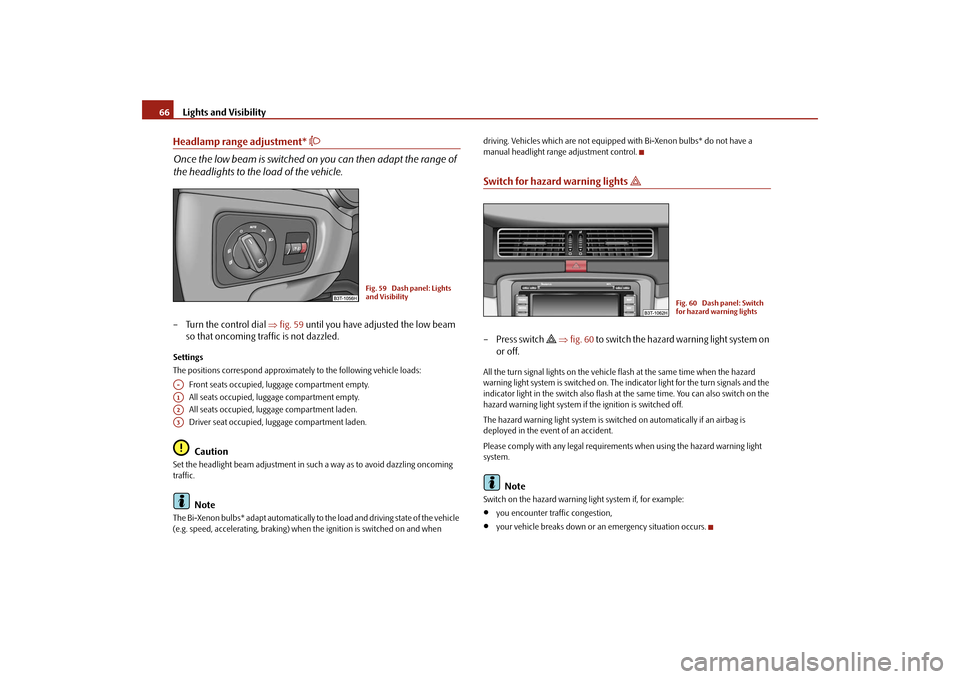
Lights and Visibility
66
Headlamp range adjustment*
Once the low beam is switched on you can then adapt the range of the headlights to the load of the vehicle.– Turn the control dial
⇒
fig. 59
until you have adjusted the low beam
so that oncoming traffic is not dazzled.
Settings The positions correspond approximat
ely to the following vehicle loads:
Front seats occupied, lu
ggage compartment empty.
All seats occupied, luggage compartment empty. All seats occupied, luggage compartment laden.Driver seat occupied, luggage compartment laden.Caution
Set the headlight beam adjustment in su
ch a way as to avoid dazzling oncoming
traffic.
Note
The Bi-Xenon bulbs* adapt automatically to
the load and driving state of the vehicle
(e.g. speed, accelerating, br
aking) when the ignition is switched on and when
driving. Vehicles which are not equipped
with Bi-Xenon bulbs* do not have a
manual headlight range adjustment control.Switch for hazard warning lights
–Press switch
⇒
fig. 60
to switch the hazard warning light system on
or off.
All the turn signal lights on the vehicle
flash at the same time when the hazard
warning light system is switched on. The indicator light for the turn signals and the indicator light in the switch also flash at the same time. You can also switch on the hazard warning light system if the ignition is switched off. The hazard warning light system is switch
ed on automatically if an airbag is
deployed in the event of an accident. Please comply with any legal requirements when using the hazard warning light system.
Note
Switch on the hazard warning
light system if, for example:
•
you encounter traffic congestion,
•
your vehicle breaks down or an emergency situation occurs.
Fig. 59 Dash panel: Lights and Visibility
A-A1A2A3
Fig. 60 Dash panel: Switch for hazard warning lights
s2dk.1.book Page 66 Wednesday, April 8, 2009 12:23 PM
Page 68 of 294
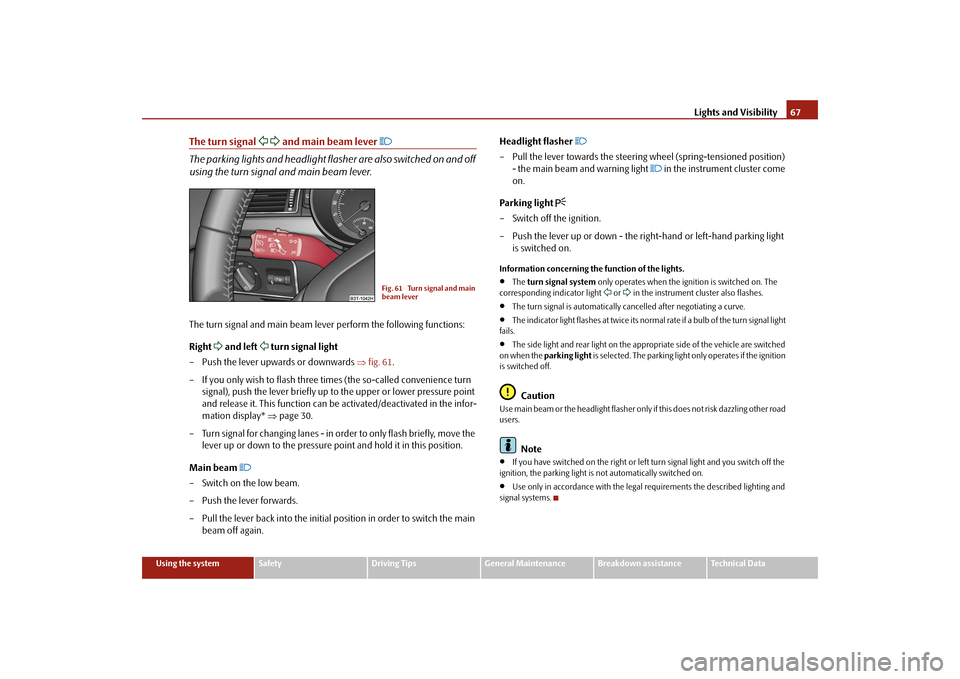
Lights and Visibility
67
Using the system
Safety
Driving Tips
General Maintenance
Breakdown assistance
Technical Data
The turn signal
and main beam lever
The parking lights and headlight flas
her are also switched on and off
using the turn signal and main beam lever.The turn signal and main beam lever perform the following functions: Right
and left
turn signal light
– Push the lever upwards or downwards
⇒
fig. 61
.
– If you only wish to flash three ti
mes (the so-called convenience turn
signal), push the lever briefly up to the upper or lower pressure point and release it. This function can be activated/deactivated in the infor-mation display*
⇒
page 30.
– Turn signal for changing lanes - in or
der to only flash briefly, move the
lever up or down to the pressure po
int and hold it in this position.
Main beam
– Switch on the low beam. – Push the lever forwards.– Pull the lever back into the initial position in order to switch the main
beam off again.
Headlight flasher
– Pull the lever towards the steering
wheel (spring-tensioned position)
- the main beam and warning light
in the instrument cluster come
on.
Parking light
– Switch off the ignition. – Push the lever up or down - the right-hand or left-hand parking light
is switched on.
Information concerning the function of the lights.•
The
turn signal system
only operates when the ignition is switched on. The
corresponding indicator light
or in the instrument cluster also flashes.
•
The turn signal is automatically cancelled after negotiating a curve.
•
The indicator light flashes at twice its normal
rate if a bulb of the turn signal light
fails.•
The side light and rear light on the appropriate side of the vehicle are switched
on when the
parking light
is selected. The parking light only operates if the ignition
is switched off.
Caution
Use main beam or the headlight flasher only if this does not risk dazzling other road users.
Note
•
If you have switched on the right or left
turn signal light and you switch off the
ignition, the parking light is not automatically switched on.•
Use only in accordance with the legal requirements the described lighting and
signal systems.
Fig. 61 Turn signal and main beam lever
s2dk.1.book Page 67 Wednesday, April 8, 2009 12:23 PM
Page 75 of 294
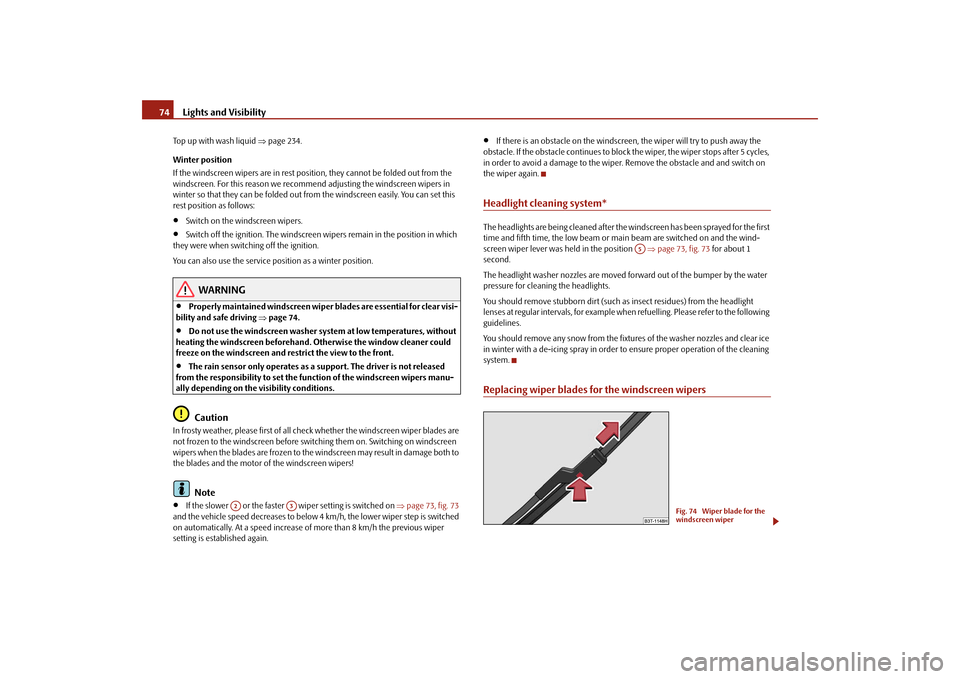
Lights and Visibility
74
Top up with wash liquid
⇒page 234.
Winter position If the windscreen wipers are in rest posi
tion, they cannot be folded out from the
windscreen. For this reason we recommend
adjusting the windscreen wipers in
winter so that they can be folded out fr
om the windscreen easi
ly. You can set this
rest position as follows:•
Switch on the windscreen wipers.
•
Switch off the ignition. The windscreen wi
pers remain in the position in which
they were when switching off the ignition. You can also use the service po
sition as a winter position.
WARNING
•
Properly maintained windscreen wiper
blades are essential for clear visi-
bility and safe driving
⇒page 74.
•
Do not use the windscreen washer sy
stem at low temperatures, without
heating the windscreen beforehand. Otherwise the window cleaner could freeze on the windscreen and re
strict the view to the front.
•
The rain sensor only operates as a
support. The driver is not released
from the responsibility to set the function of the windscreen wipers manu- ally depending on the visibility conditions.
Caution
In frosty weather, please first of all chec
k whether the windscreen wiper blades are
not frozen to the windscreen before swit
ching them on. Switching on windscreen
wipers when the blades are frozen to the windscreen may result in damage both to the blades and the motor of the windscreen wipers!
Note
•
If the slower or the faster wiper setting is switched on
⇒page 73, fig. 73
and the vehicle speed decreases to below 4
km/h, the lower wiper step is switched
on automatically. At a speed increase of
more than 8 km/h the previous wiper
setting is established again.
•
If there is an obstacle on the windscreen, the wiper will try to push away the
obstacle. If the obstacle continues to bloc
k the wiper, the wiper stops after 5 cycles,
in order to avoid a damage to the wiper.
Remove the obstacle and and switch on
the wiper again.Headlight cleaning system*The headlights are being cleaned after the
windscreen has been sprayed for the first
time and fifth time, the low beam or ma
in beam are switched on and the wind-
screen wiper lever was held in the position
⇒page 73, fig. 73
for about 1
second. The headlight washer nozzles are moved fo
rward out of the bumper by the water
pressure for cleaning the headlights. You should remove stubborn dirt (such
as insect residues) from the headlight
lenses at regular intervals, for example when refuelling. Please refer to the following guidelines. You should remove any snow from the fixtures of the washer nozzles and clear ice in winter with a de-icing spray in order to ensure proper operation of the cleaning system.Replacing wiper blades for the windscreen wipers
A2
A3
A5
Fig. 74 Wiper blade for the windscreen wiper
s2dk.1.book Page 74 Wednesday, April 8, 2009 12:23 PM
Page 82 of 294
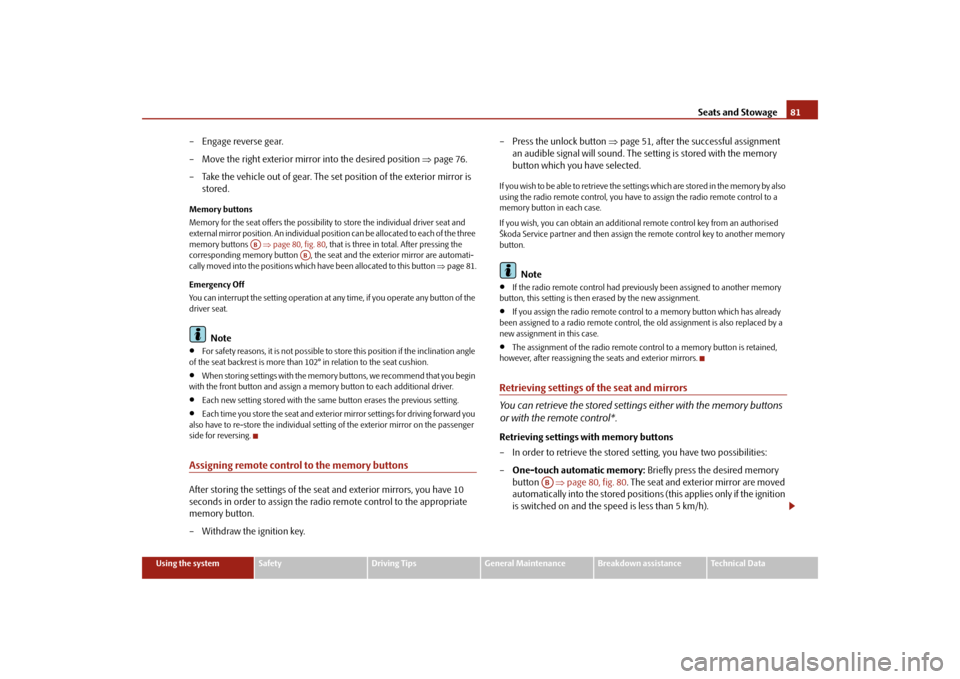
Seats and Stowage
81
Using the system
Safety
Driving Tips
General Maintenance
Breakdown assistance
Technical Data
– Engage reverse gear. – Move the right exterior mirror into the desired position
⇒
page 76.
– Take the vehicle out of gear. The set position of the exterior mirror is
stored.
Memory buttons Memory for the seat offers the possibility
to store the individual driver seat and
external mirror position. An individual posi
tion can be allocated to each of the three
memory buttons
⇒page 80, fig. 80
, that is three in tota
l. After pressing the
corresponding memory button , the seat and the exterior mirror are automati-cally moved into the positions which
have been allocated to this button
⇒page 81.
Emergency Off You can interrupt the setting operation at any time, if you operate any button of the driver seat.
Note
•
For safety reasons, it is not possible to store this position if the inclination angle
of the seat backrest is more than 102° in relation to the seat cushion.•
When storing settings with the memory buttons, we recommend that you begin
with the front button and assign a memo
ry button to each additional driver.
•
Each new setting stored with the same
button erases the previous setting.
•
Each time you store the seat and exterior mirror settings for driving forward you
also have to re-store the individual setting
of the exterior mirror on the passenger
side for reversing.Assigning remote control to the memory buttonsAfter storing the settings of the seat
and exterior mirrors, you have 10
seconds in order to assign the radio remote control to the appropriate memory button. – Withdraw the ignition key.
– Press the unlock button
⇒
page 51, after the successful assignment
an audible signal will sound. The setting is stored with the memory button which you have selected.
If you wish to be able to retrieve the settings which are stored in the memory by also using the radio remote control, you have
to assign the radio remote control to a
memory button in each case. If you wish, you can obtain an additional
remote control key from an authorised
Škoda Service partner and then assign th
e remote control key to another memory
button.
Note
•
If the radio remote control had previous
ly been assigned
to another memory
button, this setting is then erased by the new assignment.•
If you assign the radio remote control
to a memory button which has already
been assigned to a radio remote control,
the old assignment is also replaced by a
new assignment in this case.•
The assignment of the radio remote cont
rol to a memory button is retained,
however, after reassigning the seats and exterior mirrors.Retrieving settings of the seat and mirrors You can retrieve the stored settings either with the memory buttons or with the remote control*.Retrieving settings with memory buttons – In order to retrieve the stored setting, you have two possibilities: –
One-touch automatic memory:
Briefly press the desired memory
button
⇒
page 80, fig. 80
. The seat and exterior mirror are moved
automatically into the stored position
s (this applies only if the ignition
is switched on and the speed is less than 5 km/h).
AB
AB
AB
s2dk.1.book Page 81 Wednesday, April 8, 2009 12:23 PM
Page 87 of 294
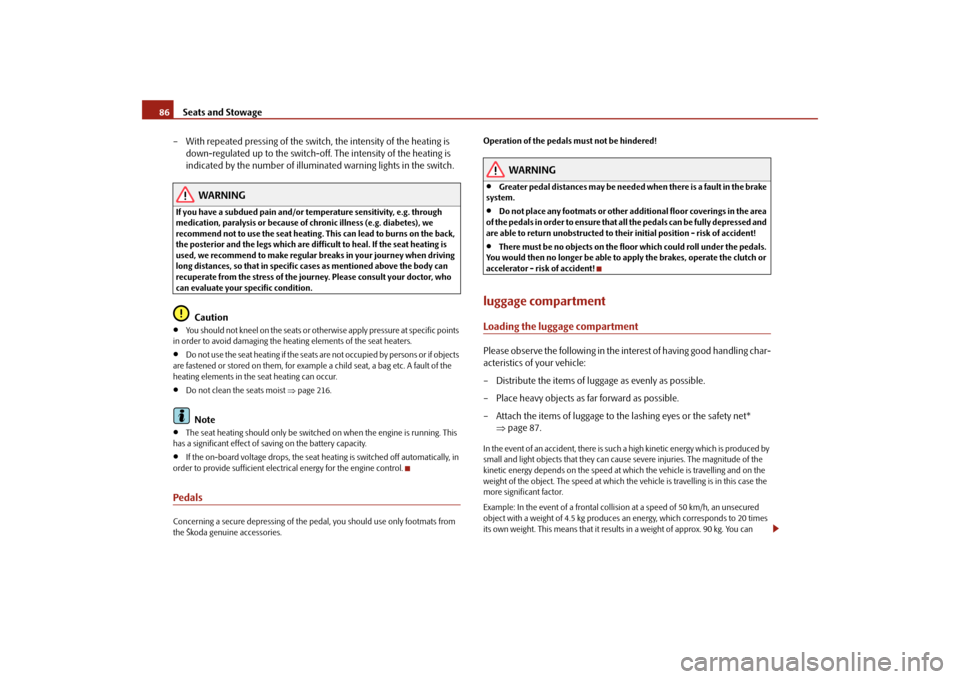
Seats and Stowage
86
– With repeated pressing of the switch, the intensity of the heating is
down-regulated up to the switch-off. The intensity of the heating is indicated by the number of illuminated warning lights in the switch.
WARNING
If you have a subdued pain and/or temperature sensitivity, e.g. through medication, paralysis or because of chronic illness (e.g. diabetes), we recommend not to use the seat heating. This can lead to burns on the back, the posterior and the legs which are diff
icult to heal. If the seat heating is
used, we recommend to make regular br
eaks in your journey when driving
long distances, so that in specific cases as mentioned above the body can recuperate from the stress of the journey. Please consult your doctor, who can evaluate your specific condition.
Caution
•
You should not kneel on the seats or otherwise apply pressure at specific points
in order to avoid damaging the heating elements of the seat heaters.•
Do not use the seat heating if the seats are not occupied by persons or if objects
are fastened or stored on them, for exampl
e a child seat, a bag etc. A fault of the
heating elements in the seat heating can occur.•
Do not clean the seats moist
⇒page 216.
Note
•
The seat heating should only be switched
on when the engine is running. This
has a significant effect of sa
ving on the battery capacity.
•
If the on-board voltage drops, the seat
heating is switched off automatically, in
order to provide sufficient electrical energy for the engine control.PedalsConcerning a secure depressi
ng of the pedal, you should use only footmats from
the Škoda genuine
accessories.
Operation of the pedals must not be hindered!
WARNING
•
Greater pedal distances may be needed when there is a fault in the brake
system.•
Do not place any footmats or other additional floor coverings in the area
of the pedals in order to ensure that all the pedals can be fully depressed and are able to return unobstructed to thei
r initial position - risk of accident!
•
There must be no objects on the floor which could roll under the pedals.
You would then no longer be able to
apply the brakes, operate the clutch or
accelerator - risk of accident!luggage compartmentLoading the luggage compartmentPlease observe the following in the inte
rest of having good handling char-
acteristics of
your vehicle:
– Distribute the items of luggage as evenly as possible. – Place heavy objects as far forward as possible.– Attach the items of luggage to the lashing eyes or the safety net*
⇒
page 87.
In the event of an accident, there is such a
high kinetic energy which is produced by
small and light objects that they can caus
e severe injuries. The magnitude of the
kinetic energy depends on the speed at wh
ich the vehicle is travelling and on the
weight of the object. The speed at which the
vehicle is travelling
is in this case the
more significant factor. Example: In the event of a frontal collision at a speed of 50 km/h, an unsecured object with a weight of 4.5 kg produces
an energy, which corresponds to 20 times
its own weight. This means that it results in a weight of approx. 90 kg. You can
s2dk.1.book Page 86 Wednesday, April 8, 2009 12:23 PM
Page 108 of 294
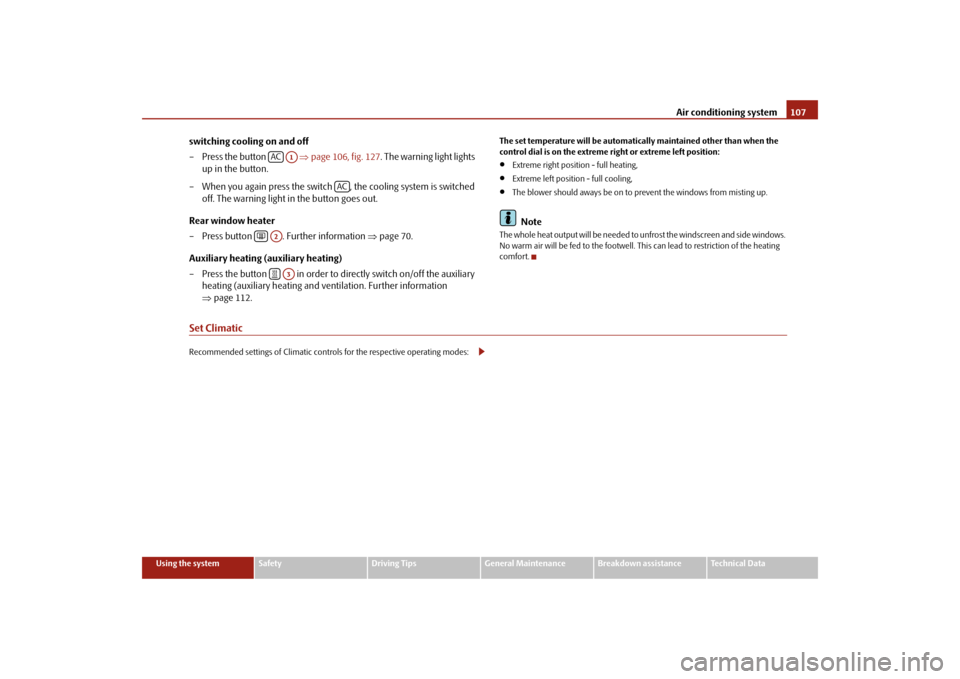
Air conditioning system
107
Using the system
Safety
Driving Tips
General Maintenance
Breakdown assistance
Technical Data
switching cooling on and off – Press the button
⇒
page 106, fig. 127
. The warning light lights
up in the button.
– When you again press the switch , the cooling system is switched
off. The warning light in the button goes out.
Rear window heater – Press button . Further information
⇒
page 70.
Auxiliary heating (auxiliary heating) – Press the button in order to directly switch on/off the auxiliary
heating (auxiliary heating and ventilation. Further information ⇒
page 112.
The set temperature will be automatica
lly maintained other than when the
control dial is on the extreme
right or extreme left position:
•
Extreme right position - full heating,
•
Extreme left position - full cooling,
•
The blower should aways be on to prevent the windows from misting up.Note
The whole heat output will be needed to
unfrost the windscreen
and side windows.
No warm air will be fed to the footwell. Th
is can lead to restriction of the heating
comfort.
Set ClimaticRecommended settings of Climatic controls for the respective operating modes:
AC
A1
AC
A2A3
s2dk.1.book Page 107 Wednesday, April 8, 2009 12:23 PM
Page 112 of 294

Air conditioning system
111
Using the system
Safety
Driving Tips
General Maintenance
Breakdown assistance
Technical Data
You can set the interior temperature between +18°C and +26°C. The interior temperature is regulated automatically with
in this range. If you chose a tempera-
ture lower than +18°C, a blue symbol lights
up at the start of the numerical scale. If
you chose a temperature higher than +26°C,
a red symbol lights up at the end of
the numerical scale. In both limit positio
ns the Climatronic operates at maximum
cooling or heating capacity, respectively. Th
e temperature is not controlled in this
case. Lengthy and uneven distribution
of the air flow out of the
vents (in particular at the
leg area) and large differences in temperature, for example when getting out of the vehicle, can result in chills in sensitive persons.Recirculated air mode In recirculated air mode air is sucked
out of the interior of the vehicle
and then fed back into the interior
. When the automatic air distribu-
tion control is switched on, an air quality sensor measures the concentration of pollutants in the drawn-in air.Recirculated air mode prevents polluted air outside the vehicle from getting into the vehicle, for example when driving through a tunnel or when standing in a traffic jam. If a considerable increase in concentration of pollutants is recognized by the air quality sensor, when the automatic air distribution control is switched on, the air distribution control will temporarily be switched off. If the concentration of pollutants decreases to the normal level, the air distributi
on control is automatically switched
off so that fresh air can be guided into the vehicle interior. Switching recirculated air mode on – Press the button repeatedly until the warning light on the left
side of the button lights up.
Switch on automatic air distribution control – Press the button repeatedly until the warning light on the right
side of the button lights up.
Switch off automatic air distribution control temporarily – If the air quality sensor does not switch on the air distribution control
automatically when there is a nauseating smell, you can switch it on yourself by pressing the button *. The warning light lights up in the button on the left side.
Switching recirculated air mode off – Press the button or press the button repetitively, until the
warning lights in the button go out.
WARNING
You should not leave recirculated air mode on over a longer period of time, as “stale” air may result in fatigue in the driver and occupants, divert your attention and also cause the windows to mist up. The risk of having an acci- dent increases. Switch recirculated air mode off as soon as the windows begin misting up.
Note
•
If the windscreen mists up, press the button
⇒page 109, fig. 128
.
After the windscreen has been demisted, press the button .•
The automatic air distribution control operates only if the outside temperature
is higher than approx. 2°C.Controlling blower There are a total of seven blower stages available.The Climatronic system controls the bl
ower stages automatically in line
with the interior temperature. You can also, however, adapt the blower stages manually to suit your particular needs. – Press again the button on the left
side (reduce blower speed) or on
the right side (increase blower speed).
AUTO
A1
AUTO
s2dk.1.book Page 111 Wednesday, April 8, 2009 12:23 PM